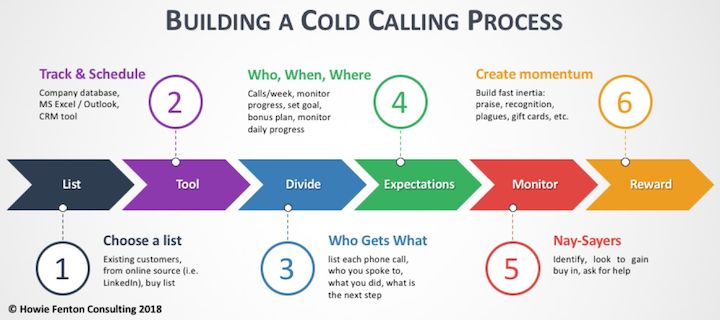Are you frustrated that your sales force focuses more on maintaining existing customers than finding new customers?
Are you afraid that your company’s sales process is based more on customers calling salespeople as opposed to salespeople calling customers?
If you answered yes to either or both questions, you might consider creating a cold calling sales process and manage it with tools. This is the first in a two-part series; the next blog will discuss the role of CRM (customer relationship management) software.
Let’s be honest. Few people like cold calls and most salespeople will avoid cold calls at all costs. The best sales companies build a process and structure to support and monitor cold calling efforts. The support often includes tools to track and schedule events. Some small companies use an Excel spreadsheet and an Outlook Schedule.
The advantage of these tools is that they are readily available, but the disadvantage is that others (customer support, production) may not be able to access the data and these tools do not automate processes. However, if these tools are useful, they can demonstrate a “proof of concept” that these tools have value and can motive companies to consider moderately more expensive tools.
Prospect Lists
CRM manages contacts by using a database to track phone calls, email records, and other types of communication. A salesperson could use it to track all the contact they have with a prospect.
The process typically starts with a list of companies and names. The list could be as simple as existing customers that have not sent work for the last six months, slightly more complicated such as generating a list from LinkedIn, or more complicated as a list that is purchased.
Using LinkedIn for Prospect Lists
LinkedIn has useful information, but to take advantage of it you must join as a premium member. How to build your network is a subject for another blog, but if you are trying to contact someone outside your network, you may not be able to access their address or email. Instead, you can use LinkedIn’s InMail tool.
Buying Prospect Lists
Finally, you can buy lists of companies with names and contact information that you can call or email. Identifying the specific demographics of the business to target is a subject for another blog, but some of the factors to consider are:
- distance
- type of company
- size (sales)
- number of staff
- number of locations
- years in business
- growth
- etc.
Gaining experience with list brokers is useful for other reasons because it is a critical part of direct mail marketing campaigns. For example, local furniture stores, landscapers, auto dealers, department stores, restaurants, cable providers, and others would likely be interested in targeting new homeowners.
Anti-Spam Legislation
Be aware however that there are no-call and no-email lists, and the laws vary by country. The Canadian Anti-Spam Legislation limits who you can approach and how you can approach them. The laws are designed to limit unwanted contact, but in many cases if you request permission first, you can approach individuals.

How to Build a Cold Calling Process (6 Steps)
1. Choose a List
Start with a list (customers, online such as LinkedIn, buying a list, etc.), start talking to sales staff about cold calling, initiate one-on-one conversations and ask for suggestions.
2. Track and Schedule
Choose a tool to monitor progress and schedule tasks (company database, Excel/Outlook, CRM tool – more on that in the next blog).
3. Who Gets What
Insert the list into the CRM tool and then divide the list to different sales staff. Define how the tool is used (i.e. list each contact, include the date and subject with who it was, record what you offered, and define the next step).
4. Who, When, Where
Set expectations.
- Set up a process to monitor their progress such as talking about them individually or in a sales meeting.
- Everyone is required to perform a certain number of calls each week.
Set a goal. E.g. “We want one new customer/quarter.” - Consider a bonus program, such as “getting three new customers within one year will earn you a bonus.” Of course, you will need to be clear, because three customers ordering one box of business cards may not warrant a bonus.
- Since most people most can’t cold call all day long without feeling demoralized, recommend each salesperson schedule a time of day and/or days to make cold calls. Ask them when they are dedicating that time, and monitor them.
5. Nay-Sayers
There are often nay-sayers that will not like this and may try to sabotage the effort. If you know who they are, look for ways to motivate their “buy-in.” Perhaps ask for their help in the implementation. Give them some homework (create a list of CRM tools, which features are most important, etc.).
6. Create Momentum
Start and monitor the progress. Find early success and reward people (gift cards, plaques, printed t-shirts, etc.).
What is Churn?
Most salespeople don’t like cold calling, but most companies must figure out how to overcome churn. Churn is traditionally referred to as the rate of customer attrition. Companies don’t like churn, but it is a natural part of most businesses. In fact, it can be a measurement to help identify leading customers. However, even companies with low churn must identify new customers simply because most customers are ordering less print. We believe that all companies need a strategy to deal with it. We recommend starting with our 5 steps for building a cold calling process to help you find new customers as one of these strategies.
Read Part 2: Using CRM in Cold Calling.

















Great information! Good Post. It is good to see valuable information from a person who obviously has a good grasp of the subject.
I really do appreciate the level of knowledge that you bring to the table with well written articles like this, thank you!
Very Nice Information given for the growth of small traders